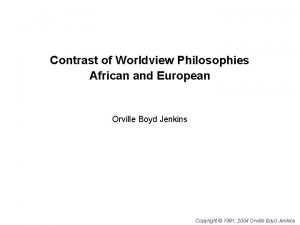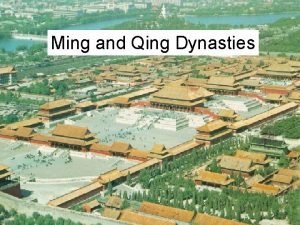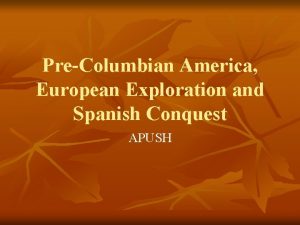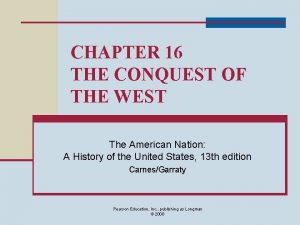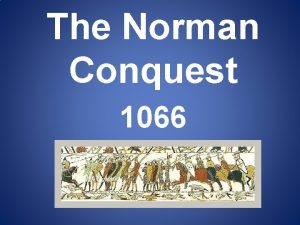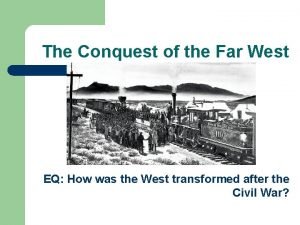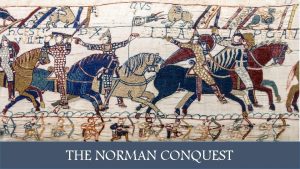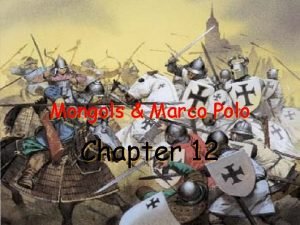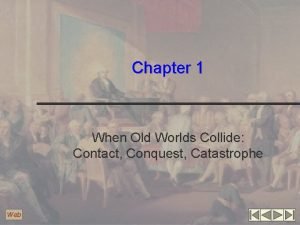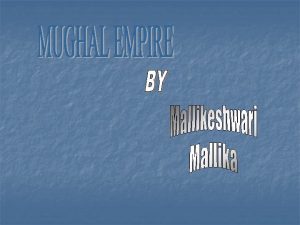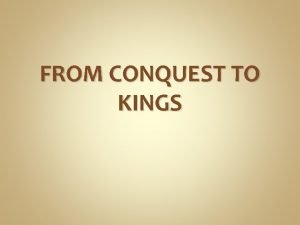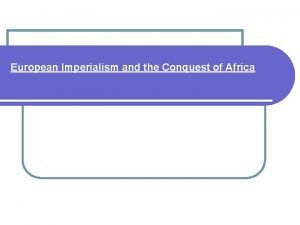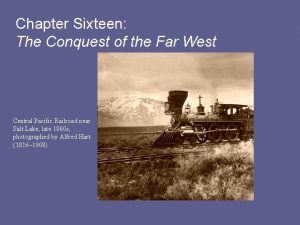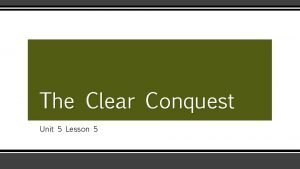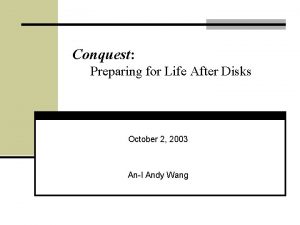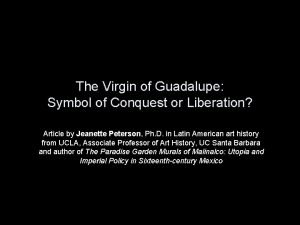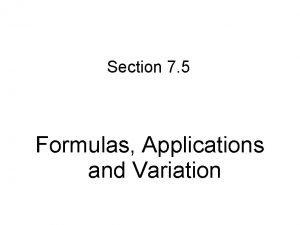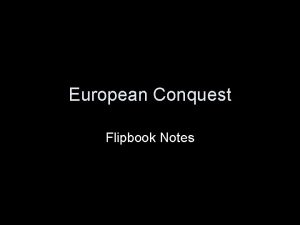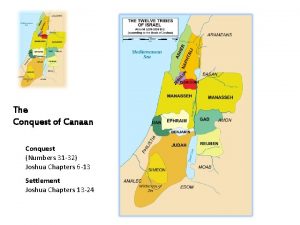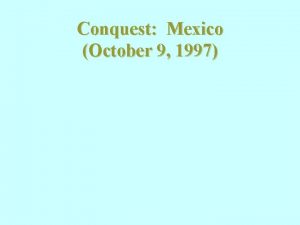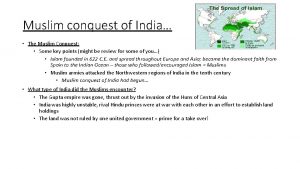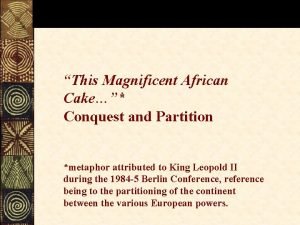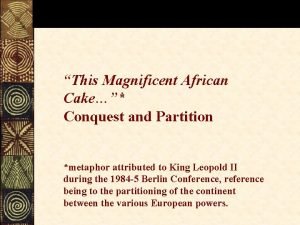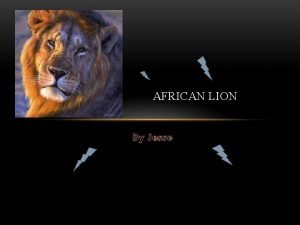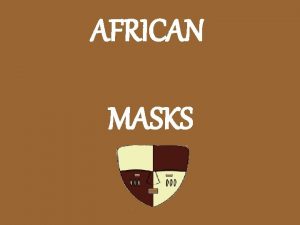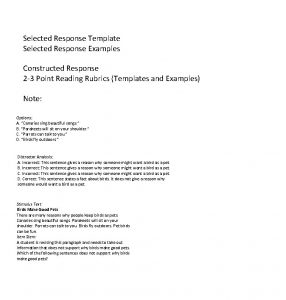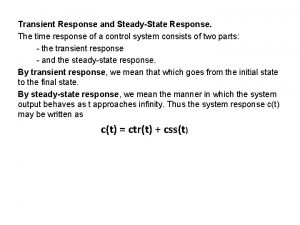AFRICAN RESPONSE TO EUROPEAN CONQUEST VARIES OF AFRICAN






























- Slides: 30

AFRICAN RESPONSE TO EUROPEAN CONQUEST

VARIES OF AFRICAN RESPONSES • • Response varied regionally and nationally Response changed overtime Early phase 1900 -1920 Initial military confrontation by African rulers whose sovereignty was threatened by European conquest Some rulers did not resist Migration Adaptation Resistance after the establishment of European colonial rule against certain policies

VARIETIES OF AFRICAN RESPONSE • African Response 1920 s-1940 s • Led by new social groups: workers, farmers, women, and the educated class • Labor protests and strikes • Peasants uprisings • World War II-1960: nationalism and decolonization • The nationalist movement was led by the educated class

EARLY RESISTANCE • During the nineteenth century, African perceived Europeans as trading partners • Example of The Ashanti • An empire of 125, 000 square miles • 3 -5 million inhabitants • It was a confederation of various groups • Ashanti Hene: King

• Ashanti established intensive commercial interaction with Europeans: Danish, British, and French • Production of Gold • Ashanti resisted British attempt to control them • 1874 British sacked Kumasi, the capital • Imposition of a treaty

BRITISH ASHANTI RELATIONS • • • Terms of the treaty: Annual payment of of 50, 000 ounces of gold Open the Road to Kumasi for trade British intervention in 1895 Justification: violation of 1874 treaty The British offered the king British protectorate Ashanti king refusal Military confrontation and Ashanti defeat in 1901 Exile of the royal family Confiscation of the Golden Stool

THE CASE OF SAMORI TOURE • Mandinka Empire under Samori Toure • Samori expansion in 1860 s and the creation of an empire, which included Sierra Leone, Liberia, and Ivory Coast • Establishment of an army of about 30, 000 troops • French began to consider Samori as a threat to their commercial interest in the Senegambia region • Confrontations 1882 & 1883 • 1886 Agreement and recognition of Samori’s authority south of Niger River

SAMORI TOURE

• • • Samori’s used diplomacy to avoid the French Established relations with the British in Sierra Leone Supply of Firearms Samori’s agreement with the British: Not to grant territory to another power without British Approval Changing political climate after Berlin conference British recognition of French claims Encirclement by French troops and defeat in 1898 Samori’s capture and exile in Gabon

SUCCESSFUL RESISTANCE: MENELIK OF ETHIOPIA • Roots of Ethiopian Empire • Kingdom of Axum 100– 940 AD • Royal Family Legend of Origin: King Solomon and Queen of Sheeba • Rise of Menelik II to power 1889 • His expansion and the creation of an empire


• • • Addis Ababa as the capital Italian Presence in the Red Sea and their threat to Ethiopia Menelik use of Military Power and Diplomacy French Presence in Djibouti Minilik’s maintained diplomatic relations with France and Italy Importation of weapons from France and Russia Establishment of an Italian colony in Eritrea Ethiopian-Italian Treaty of Uccialli, 1889 In 1896 Italians accused Menelik of violating the treaty Italian advance and their defeat at the battle of Adowa in March 1896

ESTABLISHMENT OF EUROPEAN COLONIAL RULE HOW DID COLONIAL POWERS RULE THEIR AFRICAN COLONIES? • Systems of administration • Early Phase 1900 -1920 s (era of resistance) • Military nature of administration • Use of force • 1920 s Transition to civilian administration •

DIFFERENT MODELS OF ADMINISTRATION • British model: • French Model • Indirect Rule (Native Administration) • Assimilation • Lord Lugard: Dual Mandate in Tropical Africa • Rationale for Indirect Rule • Assimilating Africans into French Culture

COLONIAL ECONOMIC POLICIES • European Economic Objectives: Reaching Markets and Acquiring Raw Materials • Taping African Resources through: Transport and infrastructure Examples: East Africa Railway • Development of Agriculture (Cash Crops)

COLONIAL ECONOMY: CASH CROP • Early Phase: late 19 th century-1920 s • Era of Charter Companies • Royal Niger Company, British South Africa Company, Imperial British East Africa Company • Experience of Charter Companies • Forced Labor and Exploitation

CHARTER COMPANIES IN BELGIAN CONGO • King Leopold Pledge at the Berlin Conference: suppress the East African slave trade promote humanitarian policies guarantee free trade within the colony impose no import duties for twenty years encourage philanthropic and scientific enterprises • 1880 s Decrees The State asserted rights of proprietorship over all vacant lands throughout the Congo territory. Restricting the rights of the Congolese in land ownership

BELGIAN CONGO • Production of Rubber • Establishment of Force Publique • Use of forced labor: mutilation and retribution • Joseph Conrad, Heart of Darkness • International Reaction • 1908: handing over the Congo to the Belgian Government • For further readings on Congo under Leopold: Adam Hochschild, KING LEOPOLD'S GHOST A Story of Greed, Terror and Heroism in Colonial Africa


• Charter Companies and Forced Labor: French in Cote d’Ivoire, Germans in Cameroon, and Portuguese in Mozambique • African Resistance and International Pressure • Decline of Charter Companies Model in 1920 s

CASH CROPS: AFRICAN PEASANT PRODUCTION • Encouragement of African Farmers to Grow Crops for Export • Continuation of late 19 th century pattern: • Peanuts, Palm Oil, Cocoa in West Africa • Massive Expansion in 20 th Century: Railways and Roads

AFRICAN PEASANT PRODUCTION • Cocoa in the Gold Coast • Production expansion from 13 tons 1890 s to 40, 000 tons by 1914 • Gold Coast became the largest single producer of cocoa in the world Local African Initiatives: Akwapim Peasants They viewed Cocoa as a long term investment • Cocoa production required abundant land labor • Use of domestic and slave labor in early phases • Use of migrant labor from neighboring countries

AFRICAN PEASANT PRODUCTION • Cotton in Sudan • Gezira Scheme: 1 million square acres • Production Arrangements: • Sudan Plantation Syndicate: transportation, ginning, and marketing • British colonial administration: water, seeds, and supervision • Sudanese tenants: labor • Cotton: 70% of Sudan’s export


COTTON IN EGYPT Establishment of Suez Canal 1869 • British Demand for Cotton • Cotton: 93% of Egypt Export by W. W. I • Expansion of Transportation and Light Industry • Social stratification: Landlords and Fellahin • (Peasant)

• Cotton in Uganda • Portuguese colonies in Angola and Mozambique • Decline of food production • “Cotton is the Mother of Poverty”

CASH CROP PRODUCTION: WHITE SETTLEMENT • Rationale behind European settlement • French in Algeria • Allocation of land to French settlers • Rise of settler population from 25, 000 in 1830 s to half a million in 1890 s • Turning Algerians into cheap laborers • Production of wheat, olive, wine

WHITE SETTLEMENT IN KENYA • Kenya: High Lands (Massai & Kikuyu) • White Settlement: 16, 663 in 1929 • Arabica coffee • Appropriation of Kikuyu land • Prohibition of Africans growing Arabica Coffee • Turning Africans into Squatters • 95% of Kenya’s export in 1950 s

WHITE SETTLEMENT • Northern Rhodesia • Southern Rhodesia • Angola • Mozambique

CONSEQUENCES OF CASH CROP PRODUCTION • Decline of Food Production • Dependency on single source of revenue • Uneven development • Social Stratification: Rich Cocoa Farmers, Ganda Chiefs, Muridi Shaykhs in Senegal
 African worldview vs. european worldview
African worldview vs. european worldview Qing conquest of the ming
Qing conquest of the ming Spanish exploration and conquest apush
Spanish exploration and conquest apush Musique conquest of paradise
Musique conquest of paradise Chapter 16 the conquest of the far west
Chapter 16 the conquest of the far west Norman conquest quiz
Norman conquest quiz Qing social structure
Qing social structure The conquest of the far west
The conquest of the far west Norman conquest
Norman conquest Conquest chapter 12
Conquest chapter 12 Worlds apart conquest
Worlds apart conquest Salim mughal
Salim mughal Joshua describes the conquest of canaan
Joshua describes the conquest of canaan Conquest
Conquest The conquest of the far west
The conquest of the far west The clear conquest
The clear conquest Xoserve conquest
Xoserve conquest Early voyages of exploration
Early voyages of exploration Conquest data disks
Conquest data disks Symbol of conquest
Symbol of conquest The meaning of silence varies among cultural groups
The meaning of silence varies among cultural groups The cuticle varies in its
The cuticle varies in its Kamdou
Kamdou Example of joint variation equation
Example of joint variation equation Varies directly
Varies directly Quantity y varies inversely as quantity x
Quantity y varies inversely as quantity x Lingualized occlusion
Lingualized occlusion The drag force f on a boat varies jointly
The drag force f on a boat varies jointly Kamdou.net
Kamdou.net Direct variation equation
Direct variation equation Characteristics of direct variation
Characteristics of direct variation
